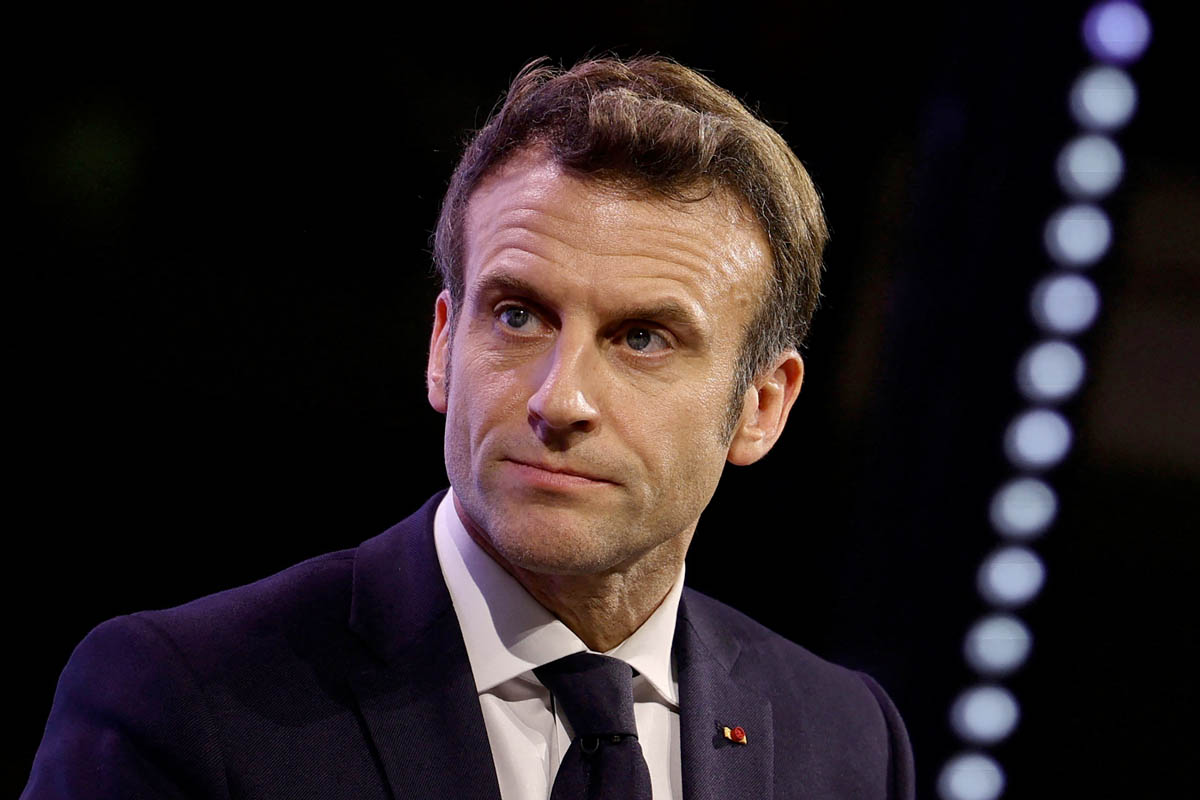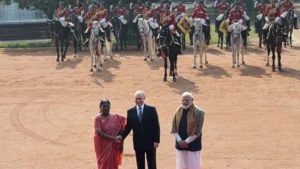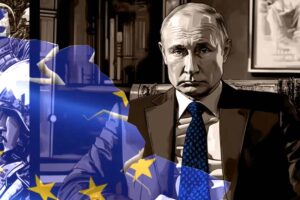This is an exceedingly rare and fascinating article in the French magazine Marianne, who got access to “several confidential defense reports” from the French army on the situation in Ukraine: https://marianne.net/monde/europe/guerre-en-ukraine-endurance-russe-echec-de-la-contre-offensive-ce-que-cache-le-virage-de-macron . This explains the state of caution to panic, what Macron’s change of heart hides.
What possessed the President to consider sending troops to Ukraine? Several confidential defence reports explain the “panic” at the Élysée Palace, where party leaders have been invited to discuss the issue on Thursday 7 March. On the front, the Russians are in a position of strength. But does that mean we should brandish an untenable threat to Putin?
By not ruling out sending troops to Ukraine, Emmanuel Macron has provoked an outcry in Europe and been rebuffed by the United States. Several French servicemen interviewed by Marianne said they had “fallen out of the cupboard”. “Let’s not kid ourselves: we’re an army of majorettes ( a young woman or girl who wears a uniform and makes a pattern of movements with a baton) against the Russians”, quipped one senior officer, who was convinced that sending French troops to the Ukrainian front would simply be “unreasonable”. At the Élysée Palace, the position is taken for granted: “The President wanted to send out a strong signal”, says an adviser, using the phrase “carefully calibrated words”.
At the Ministry of the Armed Forces, in the entourage of Sébastien Lecornu, the President’s words are defended: “The state of the forces in Ukraine is very worrying. The President’s words are a wake-up call and show that we are at a turning point.” How did we get to this point?
The situation looks exceedingly bleak for Ukraine, which might in part explain Macron’s recent declarations about sending troops to Ukraine.
A Translation of the important parts of the article :
“A Ukrainian military victory now seems impossible” The reports Marianne consulted write that Ukraine’s counter-offensive “gradually bogged down in mud and blood and did not result in any strategic gain” and that it’s planning, conceived by Kiev and Western general staffs, turned out to be “disastrous”: “Planners thought that once the first Russian defense lines were breached, the entire front would collapse […] These fundamental preliminary phases were conducted without considering the moral forces of the enemy in defense: that is, the will of the Russian soldier to hold onto the terrain”.
The reports also highlight “the inadequacy of the training of Ukrainian soldiers and officers”: due to a lack of officers and a significant number of veterans, these “Year II soldiers” from Ukraine – often trained for “no more than three weeks” – were launched into an assault on a Russian fortification line that proved impregnable.
Without any air support, with disparate Western equipment that was less efficient than the old Soviet material (“obsolete, easy to maintain, and capable of being used in degraded mode”, the report mentions), the Ukrainian troops had no hope of breaking through. Add to this the “Russian super-dominance in the field of electronic jamming penalizing, on the Ukrainian side, the use of drones and command systems”.
“The Russian army is today the ‘tactical and technical’ reference for thinking and implementing the defensive mode,” writes the report. Not only does Moscow have heavy engineering equipment that allowed it to construct defensive works (“almost total absence of this material on the Ukrainian side, and the impossibility for Westerners to supply it quickly”) but the 1,200 km front, known as the Sourokovine line (after a Russian general), has been mined to a huge extent.
The reports also highlight that contrary to Ukraine “the Russians have managed their reserve troops well, to ensure operational endurance.” According to this document, Moscow reinforces its units before they are completely worn out, mixes recruits with experienced troops, ensures regular rest periods in the rear… and “always had a coherent reserve force to manage unforeseen events.” This is far from the widespread idea in the West of a Russian army sending its troops to the slaughter without counting…
“To date, the Ukrainian general staff does not have a critical mass of land forces capable of inter-arms maneuver at the corps level capable of challenging their Russian counterparts to break through its defensive line,” concludes this confidential defense report, according to which “the gravest error of analysis and judgment would be to continue to seek exclusively military solutions to stop the hostilities”. A French officer summarizes: “It is clear, given the forces present, that Ukraine cannot win this war militarily.”
“The conflict entered a critical phase in December” “The combativeness of Ukrainian soldiers is deeply affected,” mentions a forward-looking report for the year 2024. “Zelensky would need 35,000 men per month, he’s not recruiting half of that, while Putin draws from a pool of 30,000 volunteers per month,” observes a military officer returned from Kiev. In terms of equipment, the balance is just as unbalanced: the failed offensive of 2023 “tactically destroyed” half of Kiev’s 12 combat brigades.
Since then, Western aid has never been so low. It is therefore clear that no Ukrainian offensive can be launched this year. “The West can supply 3D printers to manufacture drones or loitering munitions, but can never print men,” notes this report. “Given the situation, it may have been decided to strengthen the Ukrainian army, not with fighters, but with support forces, in the rear, allowing Ukrainian soldiers to be freed up for the front,” admits a senior officer, confirming a “ramp-up” of Western military personnel in civilian clothes. “Besides the Americans, who allowed the New York Times to visit a CIA camp, there are quite a few Britons,” slips a military officer, who does not deny the presence of French special forces, notably combat swimmers for training missions…
“The risk of a Russian breakthrough is real” On February 17, Kiev had to abandon the city of Avdiivka, in the northern suburbs of Donetsk, which had until then been a fortified stronghold. “It was both the heart and symbol of Ukrainian resistance in the Russian-speaking Donbass,” highlights a report on the “battle of Avdiivka,” drawing a series of damning lessons. “The Russians changed their modus operandi by compartmentalizing the city, and especially by using gliding bombs on a large scale for the first time,” notes this document. When a 155mm artillery shell carries 7 kg of explosive, the gliding bomb delivers between 200 and 700 kg and can thus pierce concrete structures more than 2 m thick. A hell for Ukrainian defenses, which lost more than 1,000 men per day. Furthermore, the Russians use sound suppressors on light infantry weapons to foil acoustic detection systems on the ground.
“The decision to retreat by the Ukrainian armed forces was a surprise,” notes this last report, highlighting “its suddenness and lack of preparation,” fearing that this choice was “more endured than decided by the Ukrainian command,” suggesting a possible onset of “disarray.” “The Ukrainian armed forces have tactically shown that they do not possess the human and material capabilities […] to hold a sector of the front that is subjected to the assailant’s effort,” continues the document. “The Ukrainian failure in Avdiivka shows that despite the emergency deployment of an ‘elite’ brigade – the 3rd Azov Air Assault Brigade –, Kyiv is incapable of locally restoring a sector of the front that collapses,” alerts this last report.
What the Russians will do with this tactical success remains to be seen. Will they continue in the current mode of “nibbling and slowly shaking” the entire front line, or will they seek to “breakthrough in-depth”? “The terrain behind Avdiivka allows it,” signals this recent document, also warning that Western sources tend to “underestimate” the Russians, themselves adept at the practice of “Maskirovka,” “appearing weak when strong.” According to this analysis, after two years of war, Russian forces have thus shown their ability to “develop operational endurance” that allows them to wage “a slow and long-intensity war based on the continuous attrition of the Ukrainian army.”
Source: @RnaudBertrand












